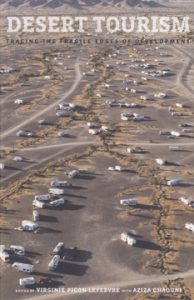Desert Tourism: Tracing the Fragile Edges of Development
 Deserts are becoming increasingly popular tourist destinations. However, the growth of this tourism niche raises particular challenges, jeopardizing their fragile ecosystems and straining scarce resources. Paradoxically, the increasing popularity of desert tourism is undermining the very essence of the allure of these places. In developing countries, the consequences are even more drastic, as local populations live in dire conditions with few resources and insufficient infrastructure, rarely benefiting from tourism’s economic effects. This book seeks to analyze the relationship between tourism and the sustainable development of those territories, addressing issues raised by architecture, landscape design, and planning. Following a historical perspective, Susan Miller, Claude Prelorenzo, Neil Levine, and Aziza Chaouni show how the imaginaire of the desert was invented by movie directors, writers, and architects. Virginie Lefebvre, Alessandra Ponte, and Kazys Varnelis explore traces of previous conflicts that transformed deserts, from war to peace, into touristic destinations and places for experimentation. Finally, an analysis of contemporary conditions helps to measure the challenges still to be faced: Vincent Battesti tackles the ethnocultural landscapes of the oasis, Chris Johnson the preservation of deserts and impacts on local communities, and Gini Lee the use of deserts as creative places for artists.
Deserts are becoming increasingly popular tourist destinations. However, the growth of this tourism niche raises particular challenges, jeopardizing their fragile ecosystems and straining scarce resources. Paradoxically, the increasing popularity of desert tourism is undermining the very essence of the allure of these places. In developing countries, the consequences are even more drastic, as local populations live in dire conditions with few resources and insufficient infrastructure, rarely benefiting from tourism’s economic effects. This book seeks to analyze the relationship between tourism and the sustainable development of those territories, addressing issues raised by architecture, landscape design, and planning. Following a historical perspective, Susan Miller, Claude Prelorenzo, Neil Levine, and Aziza Chaouni show how the imaginaire of the desert was invented by movie directors, writers, and architects. Virginie Lefebvre, Alessandra Ponte, and Kazys Varnelis explore traces of previous conflicts that transformed deserts, from war to peace, into touristic destinations and places for experimentation. Finally, an analysis of contemporary conditions helps to measure the challenges still to be faced: Vincent Battesti tackles the ethnocultural landscapes of the oasis, Chris Johnson the preservation of deserts and impacts on local communities, and Gini Lee the use of deserts as creative places for artists.
Available through Harvard University Press.
Edited by Virginie Picon-Lefebvre with Aziza Chaouni
Harvard University Graduate School of Design